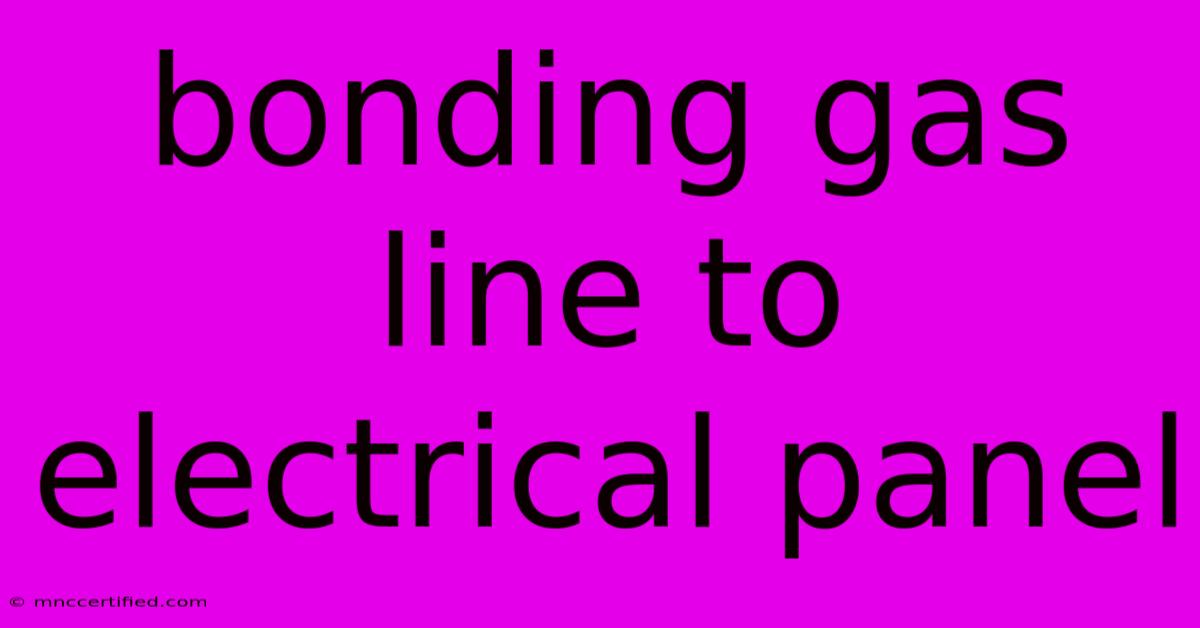Bonding Gas Line To Electrical Panel

Table of Contents
Bonding Gas Line to Electrical Panel: Safety First!
Connecting a gas line to your electrical panel, also known as gas line bonding, is a critical safety measure. It's not just about meeting electrical codes; it's about protecting you and your home from potential hazards. This article will explain why bonding is essential, how to do it correctly, and the potential consequences of neglecting this crucial step.
Why Bond Your Gas Line?
Natural gas is flammable, and a spark can ignite it. This is where electrical wiring comes into play. If a fault occurs in your electrical system, it can create a spark, potentially igniting a gas leak. Bonding creates a safe path for any stray electrical currents to flow to ground, minimizing the risk of sparks.
Here's how it works:
- Grounding: Your electrical panel is grounded to the earth, providing a path for electricity to safely escape in case of a fault.
- Bonding: By connecting the gas line to the ground, you create a continuous path for electrical currents, ensuring they don't jump to the gas line and cause a spark.
Who Needs to Bond a Gas Line?
Every home with a natural gas line should have it bonded to the electrical panel. This is a standard requirement in most building codes. If you're unsure, check with your local building inspector or a qualified electrician.
How to Bond a Gas Line
Bonding a gas line is a relatively simple process, but it's important to understand the steps and follow safety precautions:
- Locate the Bonding Point: Your electrical panel should have a dedicated bonding point, often labeled "Bonding Jumper" or "Ground Bus."
- Prepare the Gas Line: Choose a location on the gas line close to the panel. This could be the gas meter or a point where the pipe is exposed.
- Clean the Bonding Surfaces: Clean the bonding point on the electrical panel and the gas line using sandpaper or a wire brush to ensure good electrical contact.
- Install the Bonding Jumper: Connect the bonding jumper, a short length of wire typically made of copper, to the bonding point on the electrical panel and the cleaned gas line. Use a grounding clamp or a bonding lug to secure the jumper to the gas line.
- Tighten the Connections: Ensure all connections are securely tightened.
Important Note: If you are not comfortable working with electrical systems, consult a qualified electrician to perform this task.
Consequences of Not Bonding
Failing to bond your gas line can have serious consequences:
- Fire Hazard: A stray electrical current can ignite a gas leak, leading to a fire.
- Safety Risks: Uncontrolled electrical currents can create shock hazards.
- Code Violations: Not bonding your gas line can result in building code violations, potentially leading to fines or legal issues.
In Conclusion
Bonding your gas line is a crucial safety precaution that can protect your family and property from potential hazards. By following the steps outlined in this guide, you can ensure your home is up to code and safe. If you have any doubts about the process, contact a qualified electrician to ensure proper bonding and peace of mind.

Thank you for visiting our website wich cover about Bonding Gas Line To Electrical Panel. We hope the information provided has been useful to you. Feel free to contact us if you have any questions or need further assistance. See you next time and dont miss to bookmark.
Featured Posts
-
Real Sociedad Stuns Barca Amid Var Debate
Nov 11, 2024
-
Home Health Aide Liability Insurance
Nov 11, 2024
-
Watch Giants Vs Panthers Channel Time Schedule
Nov 11, 2024
-
Is Cryptex Finance A Good Investment
Nov 11, 2024
-
Bitcoin Breaks 81 000 Trump Election Impact
Nov 11, 2024